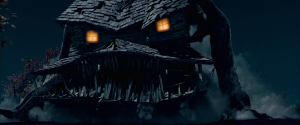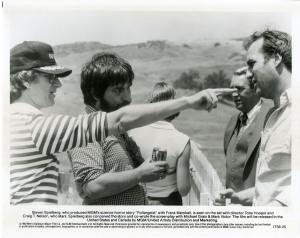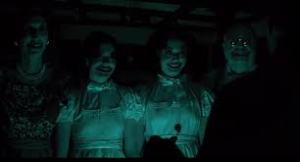Because it’s tired of other films doing the same basic plot while not technically being a remake, the classic haunted house movie Poltergeist is now officially being re-made. According to The Hollywood Reporter, MGM is partnering with Fox to co-finance and distribute the re-make from Monster House director Gil Kenan.
Now, hold on a second – I should hate this news. Poltergeist is a classic film with a sensibility unique to its era that cannot be re-created, and is more likely to simply arrive, mildly disappoint, and go away like most of the other recent 1980s film re-makes. However, if Kenan is on board we have to pay closer attention. His directorial debut, 2006′s Monster House, is one of those rare kid’s films which is legitimately too scary for most little kids. In the form of that film, Kenan has done a haunted house movie before, albeit an animated one, and he did it incredibly well. Maybe he’s the perfect guy for a Poltergeist re-make.

The titular Monster House. That’s just good family fun, though, right?
The screenplay is from David Lindsay-Abaire who has won a Pulitzer but definitely not for his most recent work – the screenplays for Oz the Great and Powerful and Rise of the Guardians. The story for the former was not particularly great, but with big-budget films it is often partially unfair to blame the screenwriter for the quality of the story, as they get the credit for what is often also the work of various producers and the director. Lindsay-Abaire won his Pulitzer for his play “Rabbit Hole,” and he wrote the screenplay for the film adaptation. He’s not without talent.
So, what is Kenan, Lindsay-Abaire, and producer Sam Raimi’s (yes, that Sam Raimi) take on the material? According THR:
“Dubbed a revisionist take on the original film, the new story centers on a family struggling to make ends meet that relocates to an outdated suburban home and is confronted by an angry spirit who kidnaps their youngest daughter and challenges them to band together to rescue her from the clutches of evil.”
Moreover, according to Moviehole even though the film will hit all of the same plot points it is more of a sequel than a remake:
In one scene in the new film, the kids’ find some things behind the sliding panel in the attic. Yep, you guessed it – they find some of the Freeling’s possessions, intentionally left behind. There’s the Star Wars bed sheets (from Robbie’s room), a black-and-white TV set (why, of course!), and some Christmas decorations.
So, it will do what the Evil Dead remake did – set the story in the same universe as the prior film(s) while also still telling the same basic story.
The original Poltergeist used the horror genre to comment upon the cost of economic expansion, with an eventual none-too-subtle reveal that houses which are built on literal graveyards aren’t going to fare well. The human villain of the film is a shady man from the real estate industry who merely moved headstones and not the actual coffins when relocating a cemetery which was in the way of a new housing development. His actions are what lead to the haunting from the supernatural villains.

The headstones from Poltergeist. This could also be the graveyeard for failed remakes of 1980s films.
With the recent housing market bubble burst which caused the recession, it would seem as if the economic conditions might provide the filmmakers the underpinning of the story. However, the remake is doomed to fail for one simple reason: you can’t outdo Steven Spielberg at the height of this powers.

Spielberg directing Craig T. Nelson on the set of Poltergeist while Tobe Hooper (in the middle) asks, “Are we even pretending that I’m the director anymore?”
The original Poltergeist is a Steven Spielberg film in every way imaginable other than one crucial credit: director. Tobe Hoober was the official director, but the film is based on an original idea of Spielberg’s and he co-wrote the screenplay. He couldn’t officially direct the film contractually because he was also making E.T. at the time, but by all accounts Spielberg was instrumental in the casting process, storyboarding, editing, and composing. In fact, due to claims from certain cast members that Spielberg was usually on-set and directing the actors the Directors Guild of America (DGA) even investigated whether or not Spielberg should be credited as co-director. Although the DGA ruled to the contrary, the notion of Spielberg being the film’s shadow director persists to this day.
The resulting film is positively Spielbergian, focusing upon the nuclear family, containing bonding moments between father and son, and revealing a deep love for genre film-making. It’s easy to see the sequence involving Craig T. Nelson easing his son’s worries about an oncoming thunderstom and think of the way Roy Schreider’s youngest son mimics his every movement in a touching sequence in Jaws. This focus upon the family gives the film its emotional center, as we see them at their best and are horrified to see them torn down so thoroughly by the time paranormal investigators meet them after youngest daughter Carol Anne has been taken by some supernatural force. The story takes every parent’s nightmare – losing a child – and turns it up to 11 through the mere introduction of the idea that Carol Anne can still be heard screaming for help but only through the television. Plus, there’s this (which horrified me as a kid and still kind of does):

If you want to do a haunted house movie just do it but don’t call it Poltergeist. That’s what Insidious did in 2010.

An image from the trailer for the forthcoming sequel to Insidious.
It rehashes most of the same basic plot points – young married couple with a kid, haunted house, kid knows about haunting before parents, quirky paranormal investigators show up only to be terrified of what they find, kid gets kidnapped to “the other side,” parent goes into netherworld to rescue kid, the end. However, Insidious has some unique elements not derived from Poltergeist, such as the concept of astral projection and that the haunting is not-site specific but person-specific meaning moving houses halfway through the film won’t solve anything. Plus, whereas when JoBeth Williams goes to “the other side” to rescue Carol Anne in Poltergeist we don’t actually see any of that whereas when Patrick Wilson goes to rescue his son Dalton we see every second of it, although the whole “the scariest parts are best left to our imagination” argument was lost on them during this sequence.
Maybe this Poltergeist re-make is happening largely because Insidious offered its own twist on the familiar story and became the most profitable film (based upon budget vs. total gross) released in 2010. I personally love a good haunted house film, and think that what Insidious and Sinister have done with the genre as of late has been brilliant. So, I’d welcome a haunted house film produced by Sam Raimi and directed by the guy who made Monster House. Just don’t call it Poltergeist. Maybe remaking rather than creating an original idea is the only way they can get the sufficient funding for such a film, but at this point the Poltergeist plot has been pilfered by others, the franchise itself died out quickly after two horribly unsatisfying sequels, and based upon recent evidence not even Spielberg could re-capture the magic of the original.
Go into the light. All our welcome, all our welcome in the light…if by “the light” I mean the comments section. All our welcome to leave a comment. Agree or disagree with my take on this re-make? Wish I had never reminded you of that creepy ass clown? Let me know in the comments.

